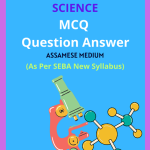Class 7 Science MCQ Chapter 3 Fibre to Fabric Solutions in English Medium, Class 7 Science Multiple Choice Question Answer in English to each chapter is provided in the list so that you can easily browse throughout different chapters Class 7 Science MCQ Chapter 3 Fibre to Fabric Notes and select need one.
Class 7 Science MCQ Chapter 3 Fibre to Fabric
Also, you can read the SCERT book online in these sections Class 7 Science Objective Type Solutions by Expert Teachers as per SCERT (CBSE) Book guidelines. These solutions are part of SCERT All Subject Solutions. Here we have given Assam Class 7 Science MCQs Solutions in English for All Subject, You can practice these here.
Fibre to Fabric
Chapter – 3
| MCQ |
1. The rearing of silk worms for the production of silk is known as:
(a) Apiculture.
(b) Silviculture.
(c) Pisciculture.
(d) Sericulture.
Ans: (d) Sericulture.
2. From which animals is silk obtained?
(a) Sheep and goats.
(b) Silkworms.
(c) Camels and llamas.
(d) Yaks and alpacas.
Ans: (b) Silkworms.
3. The caterpillars of silk worms feed on:
(a) Rose leaves.
(b) Mulberry leaves.
(c) Teak leaves.
(d) Grass.
Ans: (b) Mulberry leaves.
4. Which process is NOT involved in wool production from sheep?
(a) Shearing.
(b) Scouring.
(c) Spinning.
(d) Weaving.
Ans: (d) Weaving.
5. The process of taking out silk threads from the cocoon is called:
(a) Reeling.
(b) Rearing.
(c) Sorting.
(d) Grading.
Ans: (a) Reeling.
6. What is the source of cotton fibre?
(a) Animals.
(b) Plants.
(c) Cocoon.
(d) Sheep.
Ans: (b) Plants.
7. Which of the following animals does not yield wool?
(a) Sheep.
(b) Yak.
(c) Alpaca.
(d) Snake.
Ans: (d) Snake.
8. What is the main protein component found in silk fibres?
(a) Keratin.
(b) Collagen.
(c) Silk protein.
(d) Elastin.
Ans: (c) Silk protein.
9. The process of removal of fleece from the body of sheep is called:
(a) Cleaning.
(b) Carding.
(c) Shearing.
(d) Reeling.
Ans: (c) Shearing.
10. Which process involves removing seeds from cotton?
(a) Spinning.
(b) Sorting.
(c) Shearing.
(d) Ginning.
Ans: (d) Ginning.
11. Silk thread is obtained from:
(a) Adult moth.
(b) Pupa.
(c) Caterpillar.
(d) Cocoon.
Ans: (d) Cocoon.
12. Which of the following is a synthetic fibre?
(a) Cotton.
(b) Rayon.
(c) Silk.
(d) Polyester.
Ans: (d) Polyester.
13. Which one of the following is not an example of natural fibre?
(a) Silk.
(b) Rayon.
(c) Cotton.
(d) Wool.
Ans: (b) Rayon.
14. What is the primary use of silk fibres once they are separated from the cocoons?
(a) To make wool.
(b) To make silk threads.
(c) To make cotton cloth.
(d) To make synthetic fabric.
Ans: (b) To make silk threads.
15. The silk and wool are made of a kind of:
(a) Fats.
(b) Carbohydrates.
(c) Proteins.
(d) Vitamins.
Ans: (c) Proteins.

Hi! my Name is Parimal Roy. I have completed my Bachelor’s degree in Philosophy (B.A.) from Silapathar General College. Currently, I am working as an HR Manager at Dev Library. It is a website that provides study materials for students from Class 3 to 12, including SCERT and NCERT notes. It also offers resources for BA, B.Com, B.Sc, and Computer Science, along with postgraduate notes. Besides study materials, the website has novels, eBooks, health and finance articles, biographies, quotes, and more.



